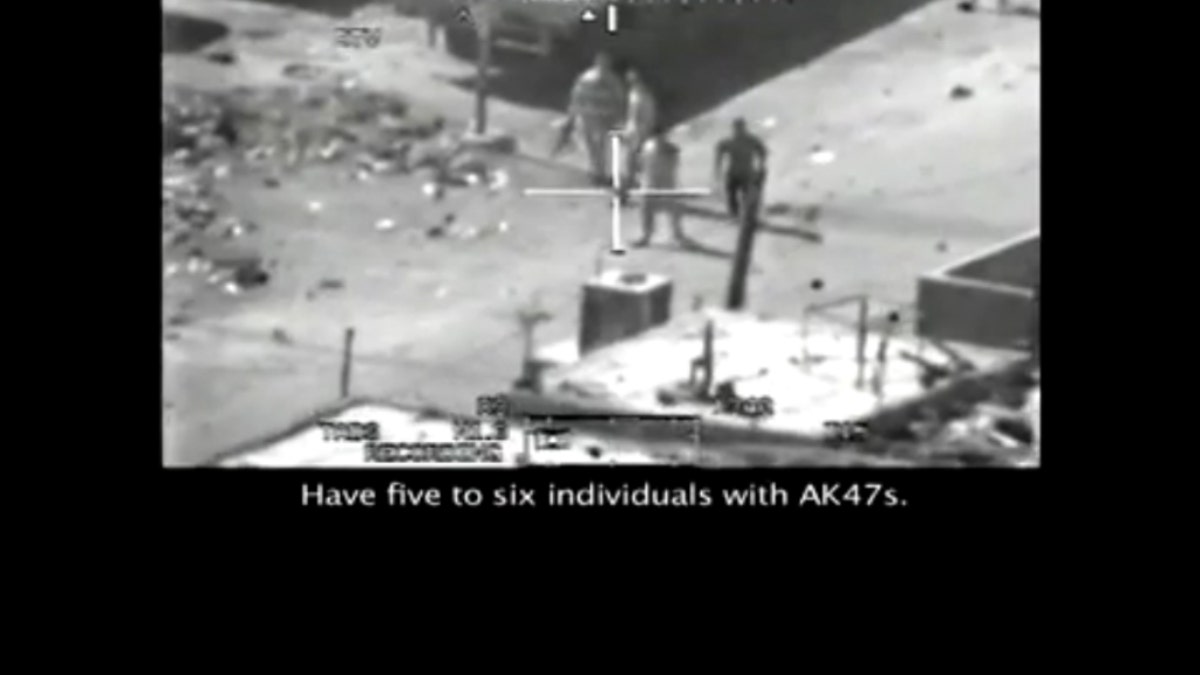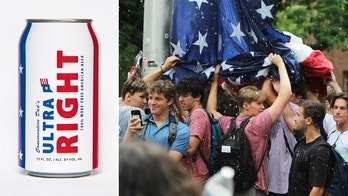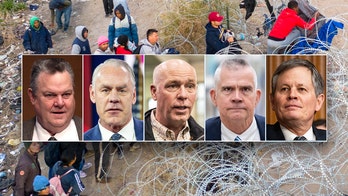
This frame grab image, taken from a video posted at Wikileaks.org, shows a group of men in the streets of the New Baghdad with weapons just prior to being fired upon by a U.S. Army Apache helicopter July 12, 2007. (FNC)
WASHINGTON, D.C. -- WikiLeaks, the self-proclaimed "whistle-blowing" investigative Web site, released a classified military video Monday that it says shows the "indiscriminate slaying" of innocent Iraqis. Two days later, questions linger about just how much of the story WikiLeaks decided to tell.
At a press conference in Washington, D.C., WikiLeaks accused U.S. soldiers of killing 25 civilians, including two Reuters journalists, during a July 12, 2007, attack in New Baghdad. The Web site titled the video "Collateral Murder," and said the killings represented "another day at the office" for the U.S. Army.
The military has always maintained the attacks near Baghdad were justified, saying investigations conducted after the incident showed 11 people were killed during a "continuation of hostile activity." The military also admits two misidentified Reuters cameramen were among the dead.
WikiLeaks said on Monday the video taken from an Army helicopter shows the men were walking through a courtyard and did nothing to provoke the attack. Their representatives said when the military mistook cameras for weapons, U.S. personnel killed everyone in sight and have attempted to cover up the murders ever since.
The problem, according to many who have viewed the video, is that WikiLeaks appears to have done selective editing that tells only half the story. For instance, the Web site takes special care to slow down the video and identify the two photographers and the cameras they are carrying.
However, the Web site does not slow down the video to show that at least one man in that group was carrying a rocket-propelled grenade launcher, a clearly visible weapon that runs nearly two-thirds the length of his body.
WikiLeaks also does not point out that at least one man was carrying an AK-47 assault rifle. He is seen swinging the weapon below his waist while standing next to the man holding the RPG.
"It gives you a limited perspective," said Capt. Jack Hanzlik, a spokesman for U.S. Central Command. "The video only tells you a portion of the activity that was happening that day. Just from watching that video, people cannot understand the complex battles that occurred. You are seeing only a very narrow picture of the events."
Hanzlik said images gathered during a military investigation of the incident show multiple weapons around the dead bodies in the courtyard, including at least three RPGs.
"Our forces were engaged in combat all that day with individuals that fit the description of the men in that video. Their age, their weapons, and the fact that they were within the distance of the forces that had been engaged made it apparent these guys were potentially a threat," Hanzlik said.
Military officials have also pointed out that the men in the video are the only people visible on those streets. That indicated something was going on and that these individuals still felt they could walk freely, one official told Fox News.
Julian Assange, a WikiLeaks editor, acknowledged to Fox News in an interview Tuesday evening that "it's likely some of the individuals seen in the video were carrying weapons."
Assange said his suspicions about the weapons were so strong that a draft version of the video they produced made specific reference to the AK-47s and RPGs. Ultimately, Assange said, WikiLeaks became "unsure" about the weapons. He claimed the RPG could have been a camera tripod, so editors decided not to point it out.
"Based upon visual evidence I suspect there probably were AKs and an RPG, but I'm not sure that means anything," Assange said. Nearly every Iraqi household has a rifle or an AK. Those guys could have just been protecting their area."
The military has said Army units on the ground were experiencing RPG fire before calling in close air support. And although it could be argued AK-47 rifles are common household items, RPGs are not.
Assange said video evidence of the cameras was much clearer than it was of the weapons and that military statements about the presence of weapons had already been widely distributed. But critics say those watching the video online or on television for the first time may not have had any knowledge of those statements.
"It's ludicrous to allege that we have taken anything out of context in this video," Assange told Fox News.
Another point of contention comes later in the video when U.S. Apache helicopters open fire on two men in a van who had arrived at the courtyard to carry away one of the wounded. It was later learned that the wounded man was one of the photographers. WikiLeaks argues that attack violated the Army's rules of engagement. However, the military says that because the van had no visible markings to suggest it was an ambulance or a protected vehicle, it was fair game under Army rules.
According to Assange the assault on the van was the most damning piece of video evidence. "I'm very skeptical that was done under the rules of engagement; and if it was legal, the rules of engagement must be changed," Assange said.
So far the rules of engagement in Iraq have not changed.
Hanzlik called the death of the Reuters photographers "incredibly unfortunate." That sad part is, he said, they weren't wearing any markings or jerseys that would have signaled to U.S. forces they were members of the media.
WikiLeaks has another classified military video in their possession they plan to release in about a month. This time, Assange said, the public will see what happened during the controversial May 2009 NATO airstrike in Farah province, where Afghan officials say at least 150 civilians were killed.




